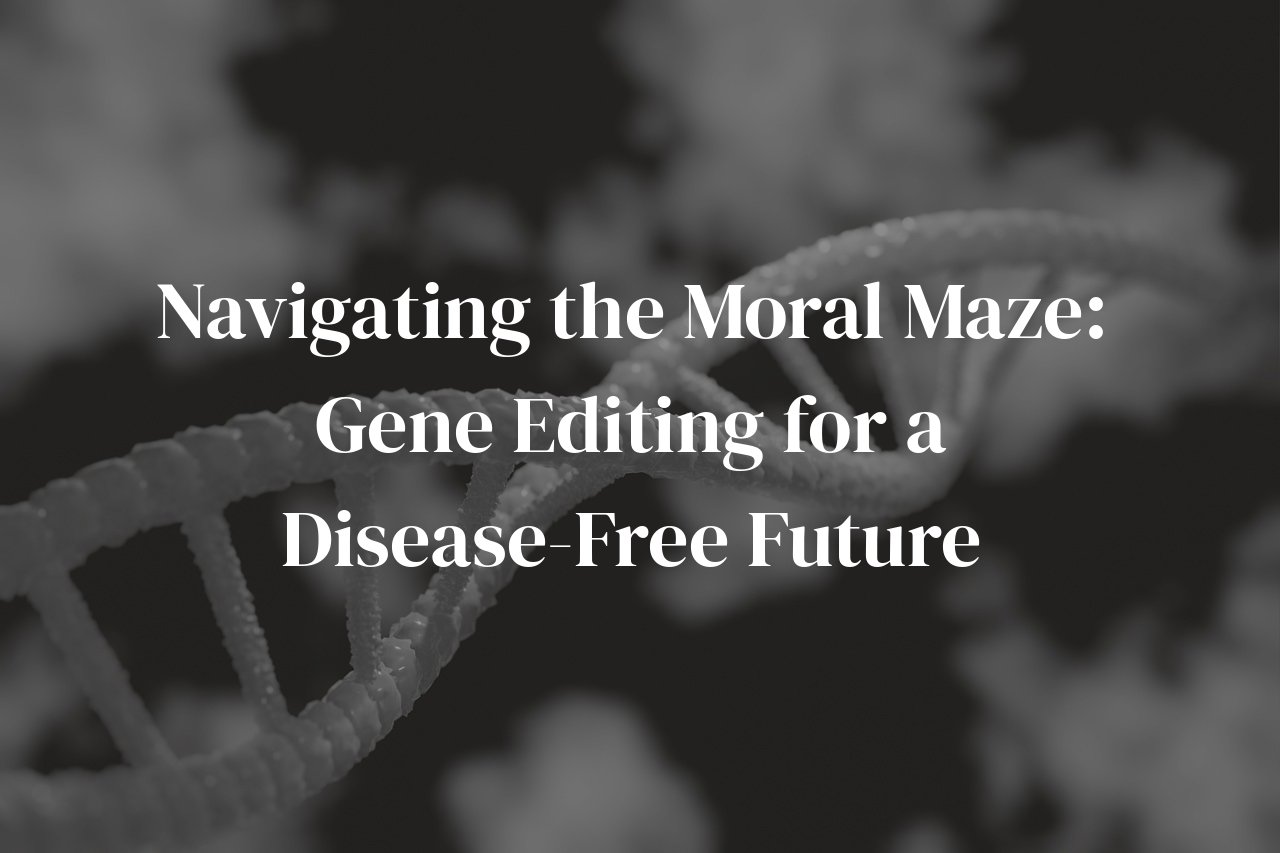
In our quest for a disease-free future, gene editing emerges as a promising frontier. This post will delve into the complex ethical considerations associated with using gene editing for disease prevention. Readers will gain insights into the potential benefits and drawbacks, societal implications, and moral dilemmas that come with this revolutionary technology. By the end of this post, you’ll be better equipped to form your own opinions and engage in informed discussions about the ethics of gene editing for disease prevention.
Table of Contents
The Promise of Gene Editing: Hopes and Aspirations
As a medicine and health blogger, I’ve had the unique privilege of delving into the intricate world of gene editing. This groundbreaking technology carries the potential to revolutionize healthcare, offering a beacon of hope for a disease-free future. However, it also brings with it a tangled web of ethical considerations that must be carefully navigated.
At the core of the promise of gene editing is its ability to eradicate genetic disorders at their very root. Imagine a world where conditions like cystic fibrosis, sickle cell anemia, and Huntington’s disease are consigned to history books. This prospect is not just a scientific marvel but a deeply human aspiration, speaking to our innate desire to alleviate suffering.
Another aspect that fuels this hope is the potential for personalized medicine. By tailoring treatments based on an individual’s genetic makeup, we can achieve greater efficacy and fewer side effects. This customized approach stands to transform patient care, making it more precise and proactive.
Beyond disease prevention and treatment, gene editing also opens up possibilities for enhancing human capabilities. While this remains a controversial topic, the idea of improving cognitive abilities, physical prowess, or even extending lifespan is a tantalizing prospect that captures the imagination.
From a public health perspective, gene editing could help mitigate the burden of infectious diseases. Techniques like gene drives could be employed to reduce the prevalence of malaria by targeting the genes of carrier mosquitoes, thus potentially saving millions of lives annually.
However, it’s not just about the science; it’s about the stories. During my research, I came across families who held onto gene editing as their last hope. Parents of children with genetic disorders spoke of sleepless nights and tireless advocacy, all for a chance at a healthier future. Their stories bring a deeply personal dimension to the scientific promise, underscoring the urgent need to translate potential into reality.
Ultimately, the promise of gene editing is a tapestry woven with threads of scientific innovation, human ambition, and heartfelt stories. As we stand on the cusp of this new frontier, it is essential to proceed with both optimism and caution, mindful of the profound implications that each step forward holds.
Ethical Dilemmas: Balancing Benefits and Risks
Gene editing, particularly via technologies such as CRISPR, holds enormous promise for eradicating genetic disorders. However, the ethical landscape is complex and requires thoughtful navigation. I recall a conversation with a geneticist friend who eagerly shared visions of a future where diseases like cystic fibrosis and Huntington’s no longer exist. Yet, this excitement is tempered by substantial ethical concerns.
The first major dilemma is the risk of unintended consequences. While the precision of gene-editing tools is improving, off-target effects can happen. These unintentional genetic changes could potentially cause new health issues or environmental impacts. I often ponder the cautionary tales that ripple through the scientific community, reminding us of the initial excitement around new technologies that later revealed unforeseen complications.
Another ethical conundrum involves germline versus somatic editing. Germline modifications affect future generations since changes are inherited. Although eradicating a debilitating genetic illness from a family line sounds miraculous, it also raises concerns about consent. Future generations cannot consent to the genetic alterations made to their lineage. This makes me think about the philosophical questions around autonomy and the rights of future people.
Equity and justice are equally pressing concerns. Who will benefit from these advancements? In a world where healthcare disparities are already significant, there is a risk that gene editing could exacerbate inequality. High costs might mean that only the wealthy could afford such treatments, leading to a society divided by genetic enhancement. This thought brings me back to reading about the ‘designer baby’ debate, where the fear is not just about disease prevention but also enhancement.
Furthermore, there’s a slippery slope argument that’s hard to ignore. What starts with noble intentions of curing illnesses could evolve into non-therapeutic enhancements aimed at improving intelligence, physical appearance, or abilities. I have had many late-night debates with colleagues about where we draw the line and who gets to make that decision. The idea that we could eventually edit for traits like intelligence or appearance introduces a level of moral complexity that is dizzying to contemplate.
Lastly, ethical oversight and governance can’t be an afterthought. Robust regulatory frameworks are essential to navigate these multifaceted ethical dilemmas. It is crucial to establish international standards and guidelines to ensure that gene editing is conducted responsibly. I once attended a bioethics conference where the call for global collaboration in setting these regulations resonated deeply with me. It was clear that without a unified approach, the risks of misuse or ethical breaches could scale out of control.
In summary, while the promises of gene editing are transformative, navigating the ethical dilemmas requires a delicate balance of enthusiasm and caution, individual considerations, and societal implications. This multifaceted issue demands ongoing dialogue and ethical vigilance to ensure that the ultimate benefits outweigh the risks.
Societal Impacts: Who Gets Access?
When it comes to the societal ramifications of gene editing, particularly for disease prevention, one of the first and most pressing questions is: who gets access? Not all communities are equally equipped to benefit from these groundbreaking advancements. This is where the conversation takes a complex turn, driven by factors like economic disparity, healthcare infrastructure, and even political landscape.
Take, for example, the economic factors. Gene editing technologies, although promising, are currently incredibly expensive. Wealthier families and individuals may find themselves at an unfair advantage, gaining access to life-saving treatments that remain out of reach for others. It raises the uncomfortable question: will this technology create a new form of genetic privilege?
Furthermore, there are questions about healthcare infrastructure. Some countries have robust healthcare systems primed to implement cutting-edge medical advancements. In contrast, other nations struggle with basic healthcare provisions. The gap could widen further, making equitable access a distant dream.
Political landscapes also play a crucial role. Some governments may be more supportive of investing in advanced medical technologies, ensuring a broader spectrum of their population benefits. Others may focus resources elsewhere, leaving a significant portion of their citizens without access to these life-altering innovations.
This brings us to another critical issue: geographical disparities. Urban centers often attract the latest medical technologies and expertise, while rural areas lag. Young families in metropolitan areas might have the luxury of opting for gene-edited treatments, while those in remote locations face lengthy journeys and limited access to the same services.
Then there’s the question of ethical considerations within societies themselves. Different cultures have varying beliefs regarding genetic modification. What might be considered a noble pursuit in one country may be deemed unethical or unnatural in another. These cultural nuances further complicate the matter of equitable access.
My personal experience as a healthcare blogger has exposed me to a range of stories that highlight these disparities. I once wrote an article about a young girl from a low-income family who was denied access to gene editing treatments for a rare but severe genetic disorder. Meanwhile, in another part of the country, a family with better financial means successfully treated a similar condition through advanced medical intervention. The stark contrast was heartbreaking and highlighted the urgent need for fairer access to such transformative medical technologies.
The quest for a disease-free future through gene editing holds immense promise, but we must navigate this terrain mindfully. Ensuring that access does not become a privilege but a right is essential for the true realization of a healthier, more equitable world.
Regulatory Landscape: Navigating Legal and Moral Territories
Gene editing, with its promise of a disease-free future, finds itself in the intricate web of regulatory landscapes defined by legal, ethical, and moral considerations. Having navigated these territories both as a medical professional and as someone who ardently follows global biotech trends, I can attest to the complexity and necessity of a balanced approach.
Firstly, different countries possess varying degrees of regulations surrounding gene editing. For example, in the United States, the FDA (Food and Drug Administration) plays a crucial role in governing gene-editing therapies. They ensure that any clinical application of gene editing is both safe and ethically justifiable. However, our European counterparts often adopt a more precautionary stance. The European Medicines Agency (EMA) not only rigorously inspects safety protocols but leans heavily into the ethical implications of genetic manipulations.
This geographical disparity leads to a phenomenon known as ‘regulatory tourism’. Researchers and patients sometimes relocate to countries with more lenient laws to either conduct their studies or seek gene editing treatments. This dynamic poses significant questions about the global harmonization of gene-editing regulations. Do we need a universal regulatory framework? And if so, who should lead this charge?
Beyond geographical considerations, the very nature of gene editing demands rigorous ethical scrutiny. Take, for instance, germline editing, which involves altering genes in human eggs, sperm, or embryos. This technique can eradicate inherited diseases but raises profound ethical and moral questions. Are we, in our quest for perfection, assuming the dangerous role of ‘playing God’? Potential unintended consequences across generations add layers of complexity to this debate.
I’ve also had the privilege of working with interdisciplinary teams that involve not only scientists and clinicians but ethicists and legal experts. These collaborations have shown me the importance of diverse viewpoints. Ethical committees often debate over the ‘Do no harm’ principle intrinsic to medical ethics versus the potential life-saving benefits of advanced gene editing techniques. The legal safeguards—and their implementation—serve as pivotal tools ensuring that advancements do not come at the cost of our moral integrity.
Furthermore, public opinion and societal values significantly influence the regulatory environment. Policies and guidelines are not created in isolation but are the fruits of extensive public consultations and debates. Regularly, I participate in public webinars and forums where people voice concerns ranging from privacy issues to the moral implications of designer babies. These participations remind me just how much the public eye keeps the scientific community in check.
In conclusion, navigating the legal and moral territories of gene editing is a challenge laden with various considerations. The responsibility lies in creating frameworks that are not only scientifically sound but ethically robust. Personalizing these journeys with my insights aims to evoke an empathetic understanding of both the promises and perils that gene editing holds. It is essential that, as we move forward, we do so with caution, empathy, and an unwavering commitment to ethical integrity.
Personal Perspectives: Stories and Opinions
The realm of gene editing is not just a technical or scientific frontier; it is deeply personal for many. Take, for example, a mother I recently spoke with. She described the emotional rollercoaster of discovering that her unborn child was diagnosed with a genetic disorder. ‘I remember the feeling of helplessness,’ she shared. ‘But the idea of gene editing gave us hope—a chance at a future where our child might not suffer.’ This sentiment is echoed by countless other parents navigating similar journeys, making it clear that the stakes are immensely high and profoundly human.
Another poignant narrative comes from a young man who has lived his entire life with cystic fibrosis. ‘It is not just about me; it is about the generations after me,’ he emphasized. ‘If gene editing can spare future children from this suffering, can we really afford not to pursue it?’ His story underscores the moral urgency felt by those living with genetic diseases, as they consider not just their own lives but the well-being of future generations.
Equally compelling are the voices of those who express caution. An ethics professor from a leading university said, ‘We must tread carefully. The power to edit genes is not just about curing diseases; it touches on the very essence of what it means to be human.’ This perspective urges a thoughtful and measured approach, ensuring that ethical boundaries are respected and societal implications thoroughly considered.
Additionally, meeting with a group of clinicians who deal with genetic disorders on a daily basis brought another layer of complexity. ‘We see both the promise and the pitfalls. On one hand, there is the potential to eradicate suffering; on the other, the risk of unforeseen consequences.’ These professionals highlight the dual-edged sword of gene editing technology, where immense potential must be balanced against the gravity of possible risks.
Yet, amidst the diverse opinions, a common thread emerges: the need for ongoing dialogue. A biotechnology student remarked, ‘It’s crucial that we keep talking—patients, doctors, scientists, ethicists. The only way forward is through collective, inclusive conversation.’ This sentiment is vital, as it acknowledges that the road to a disease-free future paved by gene editing will require the input and collaboration of all stakeholders involved.
In sharing these stories and opinions, it becomes evident that the ethical landscape of gene editing is complex and multifaceted. While there are undeniable hopes and aspirations, there are also significant moral questions that require deep, empathetic, and inclusive deliberation. As these personal narratives illustrate, the heart of this debate is not merely about technological capability but about the very essence of our shared humanity.
Conclusion
As we forge ahead into the future with gene editing technologies, it’s crucial that we navigate the ethical complexities thoughtfully and responsibly. By understanding the potential benefits and risks, considering societal impacts, and engaging in open dialogue, we can work towards a future where gene editing for disease prevention is both effective and ethically sound. Remember, the choices we make today will shape the medical landscape of tomorrow.



